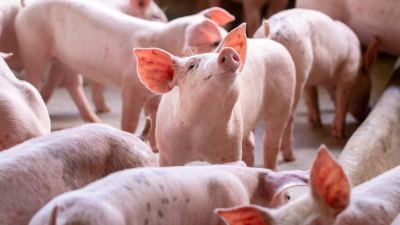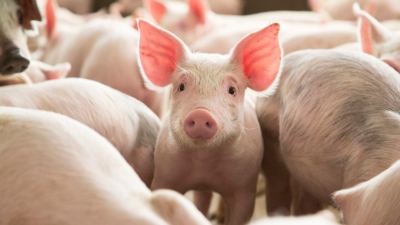Insights and tips for pig producers from the 2022 U.S. Harvest Analysis

Make sure your pig feed bins are closed and that there are no potential points of entry where moisture could get into the feedstuffs.
The presence of mycotoxins in your pig herd’s feed regimen may result in unintended consequences. These toxic substances, produced by the fungi in feedstuffs, not only have the power to negatively influence growth and performance but can also suppress long-term reproductive performance. These symptoms are not the only issues that producers may see manifest in their animals as a result of a mycotoxin problem; feed refusals, swollen vulvas in gilts and sows, and the reduced effectiveness of treatments and vaccines can also become a threat to any operation.
The Alltech 2022 U.S. Harvest Analysis is an extensive analysis of the mycotoxin risk across the country, as assessed by Alltech’s in-house mycotoxin expert, Dr. Max Hawkins. This report utilizes samples collected from throughout the country that have been analyzed through Alltech’s trusted 37+® mycotoxin analysis.
Outlined below are the key takeaways from the 2022 U.S. Harvest Analysis, as well as several proactive tips that can help pig producers mitigate their mycotoxin risk.
Here are five insights into the mycotoxin risk for the 2022 corn crop:
1. Responses to changing weather conditions
The 2022 growing season brought with it a 180-degree difference in the challenges producers faced in various regions. Drought conditions in the midwestern United States had a significant impact on corn health and yield across the western corn belt. More severe drought conditions were detected by the drought monitor in the West, and these conditions extended eastward into Illinois, Indiana and part of Ohio. Rains in late July and August eased the drought conditions east of the Mississippi River, but this rainfall — on top of already-drought-stressed corn — spurred the growth of Fusarium molds, producing a variety of type-B trichothecenes, fumonisin and zearalenone.
2. Average mycotoxin samples found
- 119 samples had an average of 6.7 mycotoxins per sample
- 98% of the samples contained two or more mycotoxins
- All samples contained between one and 12 mycotoxins each
Fusarium-produced mycotoxins were the most frequently occurring due to their preference for moist environments and moderate temperatures. The mycotoxins found most commonly in the samples included:
- Emerging mycotoxins (97.48%)
- Fusaric acid (83%)
- Type-B trichothecenes (68%)
- Fumonisin (65%)
- Zearalenone (35%)
3. Areas of greatest risk
The mycotoxins produced by molds that represented the greatest risk were type-B trichothecenes, also known as the DON family, and zearalenone. Type-B trichothecenes can negatively impact feed intake, digestion, average daily gains, feed efficiency, gut wall integrity, liver function and immune system responses. Zearalenone can act synergistically with DON to magnify the risks for reproduction, the number of pigs born, the return to estrus and conception rates. Even when the presence of these mycotoxins is lowered by the corn inclusion rate, they still represent a high risk in the finished feed.
4. Geographical location and storage differences
When it comes to Fusarium mycotoxins, the risk level tends to increase as we move from West to East. However, one factor that could increase the risk in the West is storage. Corn needs to be dried to a moisture level of 14% or less to be safely stored for extended periods of time. Across the Midwest, winter weather led to periods of cold temperatures, but in general, temperatures were above what is generally considered normal. These warmer temperatures — along with grain that was inadequately dried or left exposed to moisture — increase the likelihood of mold production and, as a result, mycotoxin growth.
5. Impact on the swine industry
The 2022 corn crop does have ranging levels of risk depending on the location of the pigs and production settings nationwide. Differing storage types could provide an environment in which the risk at harvest could increase over time. This necessitates the need for the corn to be analyzed to determine its mycotoxin levels and risk as we move through the winter and spring of 2023.
Proactive tips to help pig producers mitigate their mycotoxin risk

Make sure your feed mill is checked often.
When it comes to mycotoxins in pig feed, conducting proper testing allows for any potential risks to be managed. Dr. Hawkins shared that utilizing a mycotoxin testing program that is based on an instrument — such as HPLC MS/MS — will provide you with the most accurate and comprehensive analysis available.
Furthermore, starting the analysis of your raw materials as close to harvest as possible will ensure that you have enough time to develop an all-encompassing risk management and mitigation plan. If this analysis is properly scheduled, then your operation will have a good understanding of the risk posed by the feedstuffs being provided to your pigs prior to the animals actually receiving it.
“After utilizing comprehensive testing at harvest, you may then set up a quick analysis that can be used at your farm or mill,” said Dr. Hawkins in the U.S. Harvest Analysis webinar. “We would also suggest that you do more testing at various times throughout the year to ensure that your quick-test protocol for your grain or pig feed is still a solid plan for the production system.”
Keep feed bins dry.
Make sure your feed bins are closed and that there are no potential points of entry where moisture could get into the feedstuffs at the top of the silos.
In the summer months, feed tanks or feed bins can get very hot and are prone to sweating. Ensure that feed gets moving through the tanks or bins quickly. If there is feed leftover, transfer it to another barn.
Pay attention to feed intake.
Pigs are especially sensitive to DON; it’s like they can sense or smell it. Therefore, they tend not to eat contaminated feed. Abstaining from eating can be a classic sign that mycotoxins are present.
Instituting a proper mycotoxin management strategy will help reduce the risk of low performance in your herd. With a plan in place for mitigating mycotoxins on your operation, the chances that your pig herd will perform well in 2023 increase exponentially.















